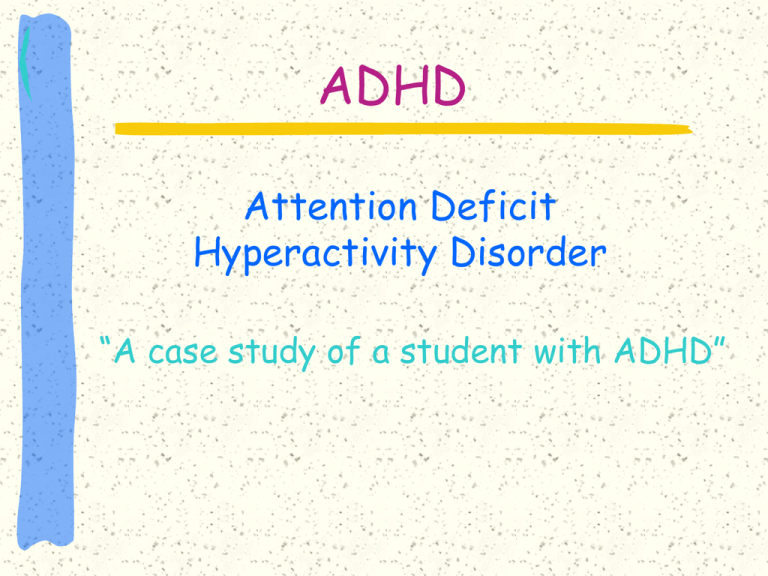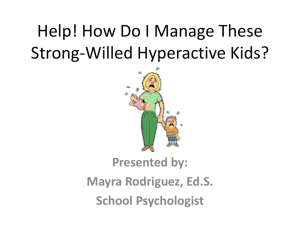Inclusion Case Study: ADHD
advertisement

ADHD Attention Deficit Hyperactivity Disorder “A case study of a student with ADHD” “The impulsive, aggressive child is constantly on the go. He runs instead of walks, acts instead of talks. These boys and girls jump headlong into new experiences, diving in first and looking later. If they learn to use their considerable energy in constructive ways, they can be energetic, creative, enthusiastic, charismatic- they become athletes, pilots, soldiers, business entrepreneurs, or politicians, perhaps” ADHD Basics Currently affects three to five percent of the population Neuropsychiatric disorder Onset before the age of 7 Problems occur in three basic domains: Attention Span, Hyperactivity, and Impulsivity Attention Span Criteria Pays little attention to details; makes careless mistakes Has short attention span Does not listen when spoken to directly Does not follow instructions; fails to finish tasks Has difficulty organizing tasks Avoids tasks that require sustained mental effort Loses things Is easily distracted Is forgetful in daily activities Hyperactivity Criteria Fidgets; squirms in seat Leaves seat in classroom when remaining seated is expected Often runs about or climbs excessively at inappropriate times Has difficulty playing quietly Talks excessively Impulsivity Criteria Blurts out answers before questions are completed Has difficulty awaiting turn Often interrupts or intrudes on others Classroom suitable for ADHD students should… …be predictable …be structured …have shorter work periods …have a smaller teacher to student ratio …have more individualized instruction …have an interesting curriculum …have more positive reinforcement Helpful Hints It is often helpful for student to be able to spread out or move around to find a more comfortable environment Fidget: piece of clay or large rubber band Meet Justin 8-year-old Third grader Diagnosed with ADHD when in first grade IQ of 115 Interested in dinosaurs and soccer Lives with his mother most often Does spend time at his dad’s sometimes Mom, Dad, and Step-dad involved in education 10 year old brother Kevin in 5th grade Justin in the classroom Justin’s main problem in the classroom is staying seated Always wants to be moving Has gotten much better at focusing since he began taking medication but he is still constantly moving Lesson on multiplication Lesson involves basic multiplication as well as simple word problems Short review of multiplication will be given and then group work as well as a worksheet Chips and tokens will be available for all student to use to help figure out the problems Adaptations for Justin Justin has a set of dinosaur cards he uses for these types of problems rather than the usual chips He has a shorter worksheet His problems relate to things that will keep his attention such as dinosaurs and soccer Ex. If the soccer team scores 5 goals in each game and they have played 7 games …how many goals have they scored in total so far this year? Curriculum Adaptations Extra time allowed to complete assignments Short and simple assignments Long tasks will be broken down into shorter chunks Helpful “neighbor” Non-verbal cues used to keep him on task Fidgets allowed Progress reports sent home each week to keep his parent involved At the end of the day I will make sure that he has all of his assignments written down and everything he needs in his backpack The computer can be used when it is relevant because it is another one of his interest Stretch breaks for the whole class Adaptations continued… Different grading techniques will be used for Justin He will get graded on the part of the paper he completes not on how much of the paper he completes Justin will be rewarded for progress he makes on his attention skills The whole class will use a token system "Having ADHD is like being put into a dark room with things scattered around to trip you. You don't get a flashlight...but everyone else does. You trip around the room, bumping into things, until you finally learn the layout of the room. Then someone moves you to a new room, and the process starts again." Bibliography “Attention Deficit Disorder in the Classroom,” Dr. Barry Sussman’s Expert Help.com http://www.expert-help.com/adhd/Classroom/classroom.html. March 20, 2003. “Attention Deficit Disorder: What Teachers Should Know” U.S. Department of Education 1994, http://www.ldonline/ld_indepth/add_adhd/add-school.html. March 19, 2003. Bos, Candace S. et al. “Targeting Home-School Collaboration for Students with ADHD” Teaching Exceptional Children July/August 1999. http://www.ldonline.org/ld_indepth/add_adhd/tec_home_school_collab.html. March 19, 2003. Brim, Sheryl A. and Dianne Whitaker. “Motivation and Students with Attention Deficit Hyperactivity Disorder” Preventing School Failure Winter 2000, Vol. 44 Issue 2. EBSCOHost, March 20, 2003. Brock, Stephen E. “Helping Students with ADHD in the Classroom,” Strategies for Teachers National Association of School Psychologists http://www.ldonline.org/ld_indepth/teaching_techniques/nasp_adhdclarm.html. March 19, 2003. Gordon, Michael. ADHD/Hyperactivity: A Consumer’s Guide DeWitt, NY: GSI Publications, 1991. Greenspan, Stanley I. The Challenging Child United States:Perseus Books, 1995. Reis, Elizabeth M. “Attention Deficit Hyperactivity Disorder: Implication for the Classroom Teacher” Journal of Instructional Psychology Sept. 2002, Vol 29 Isuue 3, EBSCO Host, March 20, 2003. Rief, Sandra. How to Reach and Teach ADD/ADHD Children West Nyack, New York: The Center for Applied Research in Education, 1993. Rief, Sandra. “Checklist for Teachers” The ADD/ADHD Checklist http://www.ldonline.org/ld_indepth/teaching_techniques/rief_checkilists.html. March 19, 2003. Schlozman, Steven C. and Vivien R. “Chaos in the Classroom: Looking at ADHD” Educational Leadership Volume 58 Number 3 November 2000, http://www.ascd.org/readingroom/edlead/0011/schlozman.html. March 20, 2003. Stevens, Suzanne. “Adjustments in Classroom Management,” Classroom Success for the LD and ADHD Child 1997, http://www.ldonline.org/ld_indepth/teaching_techniques/class_manage.html. March 19, 2003. “Teaching Children with Attention Deficit/Hyperactivity Disorder” ERIC Clearinghouse on Disabilities and Gifted Education.








